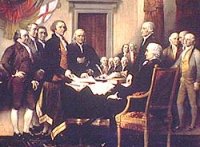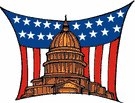By Phyllis Naegeli

|
The Declaration of Independence
By Phyllis Naegeli |

|
 1 In the 1760s, the American colonies lived under British rule and were loyal to England. They each had their own system of self-government. The colonies traded with each other, with England, and with other countries of the world. They were thriving and had large, bustling cities such as Boston, Philadelphia, and New York.
1 In the 1760s, the American colonies lived under British rule and were loyal to England. They each had their own system of self-government. The colonies traded with each other, with England, and with other countries of the world. They were thriving and had large, bustling cities such as Boston, Philadelphia, and New York. |
Create Weekly Reading Books
Prepare for an entire week at once! |
 |
The 1890's
|
 |
American Government Worksheets | edHelper.com
|
 |
High School Reading Comprehensions and High School Reading Lessons
|
 |
Social Studies
|
 |
United States
|
|
|
|
|
 | Fifty States Theme Unit |
 |
Document Based Activities |